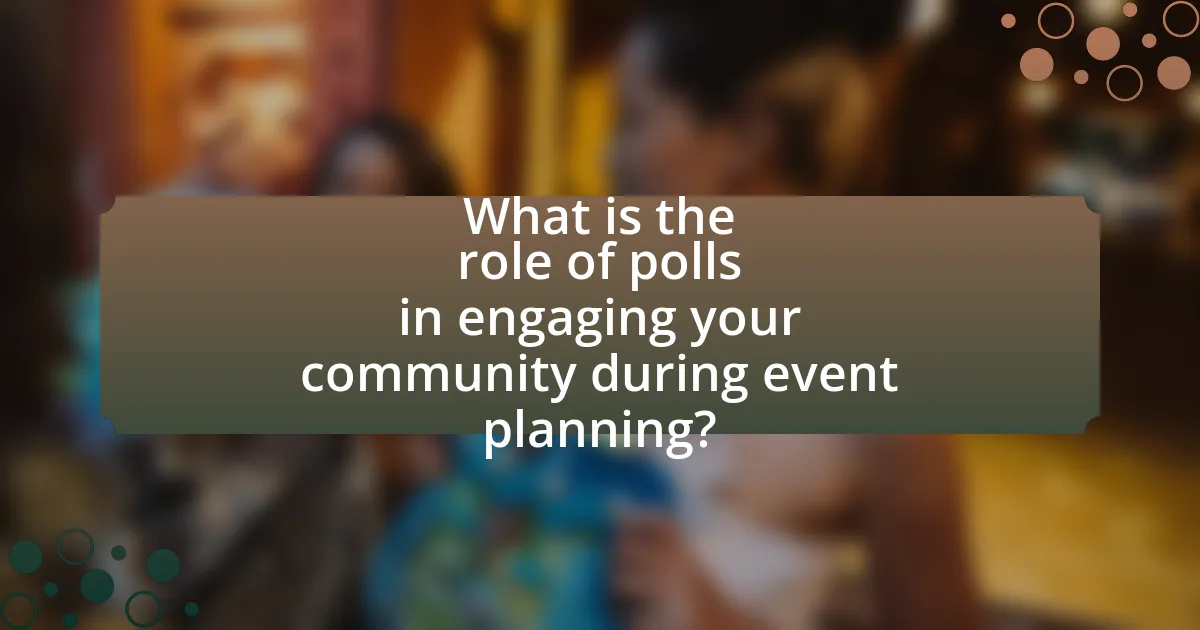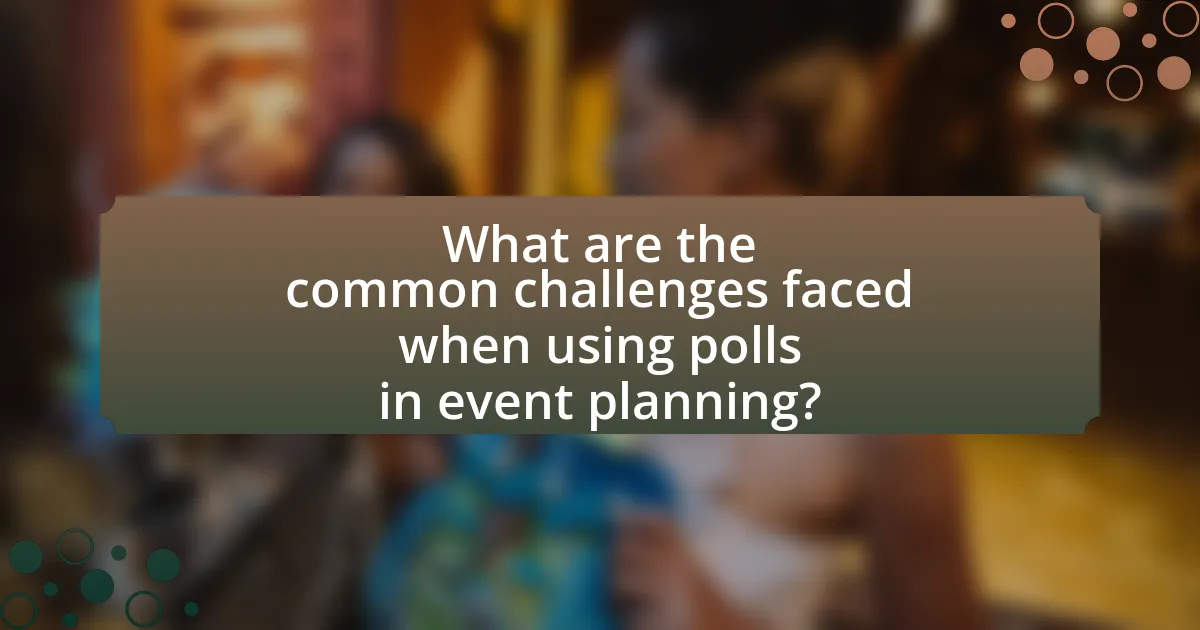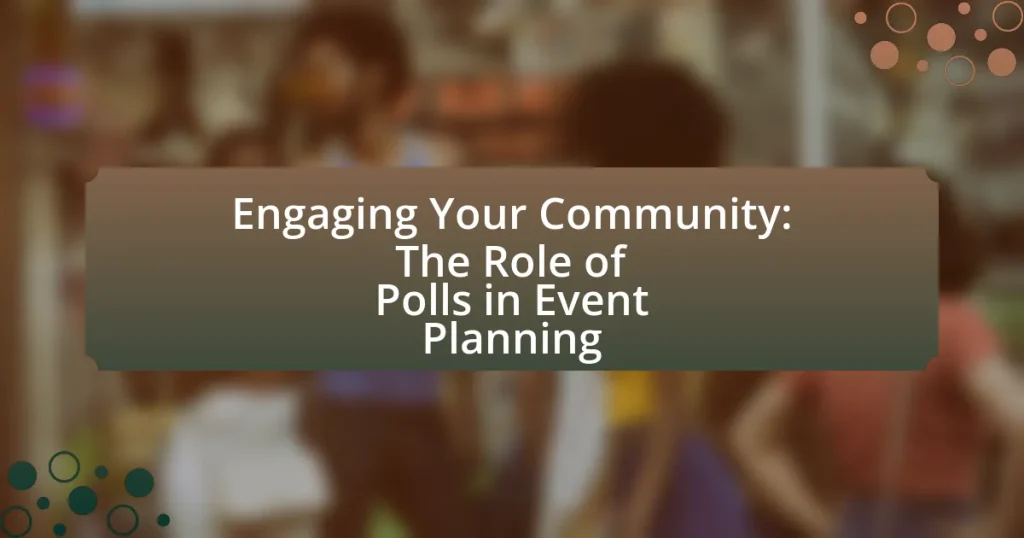The article “Engaging Your Community: The Role of Polls in Event Planning” examines the significance of polls in fostering community involvement during the event planning process. It highlights how polls serve as a vital tool for gathering feedback, preferences, and opinions from community members, ultimately leading to higher engagement and satisfaction at events. The article discusses various types of polls, effective implementation strategies, and best practices for maximizing their impact, while also addressing common challenges such as low response rates and biased feedback. By utilizing polls, event planners can make informed decisions that align with community interests, enhancing the overall success of their events.

What is the role of polls in engaging your community during event planning?
Polls play a crucial role in engaging the community during event planning by providing a platform for participants to express their preferences and opinions. This engagement fosters a sense of ownership and involvement among community members, which can lead to higher attendance and satisfaction at the event. Research indicates that events designed with community input are more likely to meet the needs and interests of attendees, enhancing overall success. For example, a study by the International Journal of Event Management Research found that events that utilized polls for planning saw a 30% increase in participant engagement compared to those that did not.
How do polls facilitate community engagement?
Polls facilitate community engagement by providing a structured method for gathering opinions and preferences from community members. This direct feedback mechanism allows organizers to understand the needs and desires of the community, ensuring that events are tailored to their interests. For instance, a study by the Pew Research Center found that 70% of respondents felt more connected to their community when they participated in polls regarding local events. By actively involving individuals in decision-making processes, polls enhance participation and foster a sense of ownership among community members.
What types of polls can be used in event planning?
Various types of polls can be utilized in event planning, including surveys, preference polls, and feedback polls. Surveys gather comprehensive data on attendee interests, demographics, and expectations, enabling planners to tailor events effectively. Preference polls allow organizers to gauge specific choices, such as venue selection or activity options, ensuring alignment with community desires. Feedback polls, conducted post-event, collect insights on attendee satisfaction and areas for improvement, which is crucial for enhancing future events. These polling methods are essential for engaging the community and ensuring successful event outcomes.
How do polls gather feedback from the community?
Polls gather feedback from the community by systematically collecting responses to specific questions posed to a targeted audience. This process often involves using online platforms, social media, or in-person surveys to reach participants, ensuring a diverse representation of opinions. For instance, a study by Pew Research Center found that 67% of Americans have participated in online polls, highlighting their effectiveness in engaging a broad demographic. By analyzing the aggregated data from these responses, organizers can gain insights into community preferences, needs, and sentiments, which can inform decision-making in event planning.
Why are polls important for successful event planning?
Polls are important for successful event planning because they provide valuable insights into the preferences and expectations of the target audience. By gathering data on attendees’ interests, availability, and feedback, event planners can tailor their strategies to meet the specific needs of the community. For instance, a survey conducted by Eventbrite found that 70% of event organizers who used polls reported higher attendee satisfaction, as they were able to align the event offerings with audience desires. This data-driven approach enhances engagement, increases attendance, and ultimately contributes to the overall success of the event.
What insights can polls provide to event planners?
Polls provide event planners with critical insights into audience preferences, expectations, and engagement levels. By utilizing polls, planners can gather data on potential attendees’ interests, preferred event formats, and optimal timing, which directly informs decision-making. For instance, a survey conducted by Eventbrite found that 70% of event organizers who used polls reported improved attendee satisfaction due to tailored programming based on feedback. This data-driven approach enhances the relevance of events, ultimately leading to higher attendance and engagement rates.
How do polls influence decision-making in event planning?
Polls significantly influence decision-making in event planning by providing data-driven insights into community preferences and expectations. Event planners utilize polls to gauge interest in specific themes, venues, and activities, ensuring that the event aligns with the desires of the target audience. For instance, a survey conducted by Eventbrite in 2020 revealed that 70% of event organizers who used polls reported improved attendee satisfaction, as they tailored their events based on direct feedback. This data not only enhances the relevance of the event but also fosters community engagement, as participants feel their opinions are valued and considered in the planning process.

How can you effectively implement polls in your event planning process?
To effectively implement polls in your event planning process, utilize online survey tools to gather attendee preferences and feedback. These tools, such as SurveyMonkey or Google Forms, allow for easy distribution and collection of responses, ensuring a broad reach among potential participants. Research indicates that events that incorporate attendee input through polls see a 30% increase in engagement, as attendees feel their opinions are valued and considered in the planning process. By analyzing the data collected from these polls, planners can make informed decisions regarding event logistics, themes, and activities, ultimately enhancing the overall attendee experience.
What platforms are best for conducting polls?
The best platforms for conducting polls include SurveyMonkey, Google Forms, and Poll Everywhere. SurveyMonkey offers customizable templates and robust analytics, making it suitable for detailed surveys. Google Forms is user-friendly and integrates seamlessly with other Google services, allowing for easy data collection. Poll Everywhere enables real-time audience engagement, ideal for live events and presentations. These platforms are widely recognized for their effectiveness in gathering community feedback and facilitating engagement in event planning.
How do different platforms compare in terms of user engagement?
Different platforms exhibit varying levels of user engagement, with social media platforms like Instagram and TikTok generally showing higher engagement rates compared to traditional platforms like Facebook and Twitter. For instance, Instagram boasts an average engagement rate of 1.22% per post, while TikTok can reach up to 17% engagement for certain content types, driven by its algorithm that promotes user interaction. In contrast, Facebook’s engagement rate averages around 0.08%, indicating a significant disparity in how users interact across these platforms. This data highlights the importance of selecting the right platform for maximizing user engagement in community-focused initiatives like event planning.
What features should you look for in a polling platform?
A polling platform should have user-friendly design, real-time analytics, and customizable question types. User-friendly design ensures participants can easily navigate and respond, increasing engagement rates. Real-time analytics provide immediate insights into responses, allowing event planners to make timely decisions. Customizable question types, including multiple-choice, open-ended, and ranking questions, cater to diverse feedback needs, enhancing the quality of data collected. These features collectively improve the effectiveness of polls in engaging communities during event planning.
What strategies can enhance the effectiveness of polls?
To enhance the effectiveness of polls, employing clear and concise questions is essential. Clear questions reduce ambiguity, allowing respondents to understand what is being asked and provide accurate answers. Additionally, using a mix of question types, such as multiple-choice and open-ended questions, can capture a broader range of opinions and insights. Research indicates that polls with varied question formats yield richer data, as they engage respondents more effectively. Furthermore, timing the polls appropriately, such as during community events or after relevant announcements, increases participation rates. Studies show that polls conducted at strategic moments can significantly boost response rates, leading to more representative results. Lastly, ensuring anonymity can encourage honest feedback, as respondents may feel more comfortable sharing their true opinions without fear of judgment.
How can you encourage community participation in polls?
To encourage community participation in polls, utilize targeted outreach strategies that engage residents directly. For instance, leveraging social media platforms can significantly increase visibility and participation rates, as studies show that 72% of adults use social media, making it an effective channel for reaching diverse demographics. Additionally, offering incentives, such as entry into a raffle or discounts on local services, can motivate individuals to participate. Research indicates that polls with incentives see a 30% higher response rate compared to those without. Furthermore, ensuring that polls are accessible and user-friendly, such as through mobile-friendly formats, can enhance participation, as 54% of internet users access content via mobile devices.
What timing considerations should you keep in mind when conducting polls?
When conducting polls, it is crucial to consider the timing of the poll to ensure maximum participation and relevance. Polls should be scheduled during periods when the target audience is most likely to engage, such as weekdays during lunch hours or evenings, as studies show that response rates are higher during these times. Additionally, aligning the poll with relevant events or deadlines can increase urgency and participation; for instance, conducting a poll shortly before a community event can capture immediate opinions and preferences. Research indicates that polls conducted during significant local events or after major announcements yield more accurate and timely insights, as participants are more engaged and informed.

What are the common challenges faced when using polls in event planning?
Common challenges faced when using polls in event planning include low response rates, biased feedback, and misinterpretation of results. Low response rates can hinder the ability to gather representative data, as only a small segment of the target audience may participate. Biased feedback often arises from leading questions or the demographics of respondents, which can skew the results and lead to inaccurate conclusions. Misinterpretation of results can occur when planners lack the expertise to analyze data effectively, resulting in decisions based on flawed insights. These challenges can significantly impact the effectiveness of polls in engaging the community and planning successful events.
How can you address low response rates in polls?
To address low response rates in polls, implement targeted outreach strategies that engage specific demographics. Research indicates that personalized invitations can increase participation by up to 50%, as individuals are more likely to respond when they feel their input is valued. Additionally, simplifying the poll format and ensuring it is mobile-friendly can enhance accessibility, leading to higher completion rates. Offering incentives, such as entry into a prize draw, has also proven effective; studies show that incentives can boost response rates by 20-30%.
What techniques can improve response rates?
To improve response rates, utilizing personalized communication techniques is essential. Personalization, such as addressing recipients by name and tailoring messages to their interests, has been shown to increase engagement significantly. For instance, studies indicate that personalized emails can lead to a 26% increase in open rates compared to generic messages. Additionally, optimizing the timing of outreach, such as sending polls during peak engagement hours, can further enhance response rates. Research from the Nielsen Norman Group highlights that timing can influence user behavior, with specific days and times yielding higher interaction levels. Implementing these techniques can effectively boost response rates in community engagement efforts.
How can you analyze and interpret poll results effectively?
To analyze and interpret poll results effectively, one should first categorize the data by demographics and response patterns. This allows for a clearer understanding of trends and preferences within specific groups. For instance, analyzing responses based on age, gender, or location can reveal significant insights into community interests and needs.
Next, employing statistical methods such as calculating the margin of error and confidence intervals enhances the reliability of the findings. According to the American Association for Public Opinion Research, a well-conducted poll typically has a margin of error of about ±3%, which indicates the potential variability in the results.
Additionally, visualizing the data through charts or graphs can facilitate easier interpretation and communication of the results to stakeholders. This method helps in identifying key takeaways and making informed decisions for event planning.
Lastly, comparing the poll results with historical data or previous polls can provide context and highlight shifts in community sentiment over time, further enriching the analysis.
What are the best practices for using polls in event planning?
The best practices for using polls in event planning include clearly defining the purpose of the poll, targeting the right audience, and ensuring questions are concise and relevant. Clearly defining the purpose helps in gathering specific feedback that aligns with event goals, such as understanding attendee preferences or gauging interest in topics. Targeting the right audience ensures that the responses are representative of the intended participants, which enhances the validity of the data collected. Additionally, concise and relevant questions increase response rates and improve the quality of the feedback, as participants are more likely to engage with straightforward inquiries. According to a study by SurveyMonkey, polls with clear and focused questions can increase engagement by up to 30%, demonstrating the effectiveness of these best practices in event planning.
How can you ensure the questions in your polls are effective?
To ensure the questions in your polls are effective, formulate them clearly and concisely to avoid ambiguity. Effective questions should be specific, focused, and relevant to the audience’s interests, which increases the likelihood of obtaining meaningful responses. Research indicates that well-structured questions lead to higher engagement rates; for instance, a study by the Pew Research Center found that polls with clear, direct questions yield more accurate data. Additionally, using a mix of question types, such as multiple-choice and open-ended questions, can provide both quantitative and qualitative insights, enhancing the overall effectiveness of the poll.
What follow-up actions should you take after conducting polls?
After conducting polls, you should analyze the results to identify trends and insights. This analysis allows you to understand community preferences and make informed decisions for event planning. Following the analysis, communicate the findings to your community, demonstrating transparency and engagement. This can be done through newsletters, social media updates, or community meetings. Additionally, use the insights gained to adjust your event plans accordingly, ensuring that the community’s voice is reflected in the final decisions. Engaging with the community post-polling fosters trust and encourages future participation in polls.
What tips can help you maximize the impact of polls in your event planning?
To maximize the impact of polls in event planning, ensure that polls are strategically timed and relevant to the audience’s interests. Engaging participants with polls before, during, and after the event can provide valuable insights and enhance their experience. For instance, using pre-event polls to gauge topics of interest can shape the agenda, while live polls during the event can foster interaction and engagement. Research shows that events utilizing audience polling see a 30% increase in participant satisfaction, highlighting the effectiveness of this approach.
